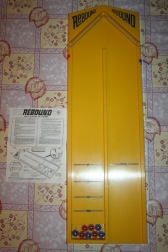Shove Ha’penny:

Number of Players: 2/4
Year of Publication: Unknown
Rebound:

Number of Players: 2/4
Year of Publication: 1971
Sliding on down – Shove Ha’penny/Rebound:
Both Shove Ha’penny and Rebound are easy to learn, quick games. Rebound is included in this post, despite the fact that it’s not a wooden game, because it’s the game Shove Ha’penny developed into in the late 20th century.
What’s in the Box:
Well, in the box for Shove Ha’penny there’s a large-ish wooden board, an instructions card, and five half penny coins.
In the box for Rebound there’s a large plastic board, two elastic bands and eight (or sixteen in our case) ball bearings with coloured rings around them.


Playing the Game:
The objective of Shove Ha’penny is to be the first player to shove three coins into the same scoring area. In Rebound it’s to be the first player to score 500 points.
The Rules:
Shove Ha’penny:
- Players take it in turns to shove all five coins into the scoring areas.
- You must not touch the board with the hand you aren’t using to move the coins, if you do, you score zero for that round.
- At the end of your turn you must let the other player remove the coins from the board, if you take them, your score for that round isn’t counted.
- If a coin ends up off the board for any reason during your turn, that coin cannot be replayed and doesn’t count towards your score.
- Any coin that finishes outside the scoring area in any way is not counted and cannot be replayed.
- Coins on the line (even the tiniest bit) don’t count only coins between the two area lines count.

Rebound:
- Players choose a colour and take the four ball bearings with their colour ring around them.
- The game progresses in rounds, players take it in turns to play one of their ball bearings, they do this until they’ve played all four of them, then the round is over, and the points are scored.
- Any ball bearing that leaves the board is not counted and cannot be replayed, the same applies to a ball that passes out the other side of the scoring area into the trench space at the end of the board.
- Points are only scored when a ball is entirely in a zone if any part of it is in a lower zone it scores the lower (or no, if its hanging into the no score zone) points. If ball is still physically on the board and not in the pit is accepted as 100 point score.

Strategy:
As far as strategy goes, there isn’t much that can be applied for these games, apart from being able to gauge well how much force is needed to get your pieces into their optimum positions. So basically having steady hands and a good gauge of force. It takes a few play of the game to get the idea of how much force you need and even after that some how your mind just keep forgetting.
History and Interesting Facts:
- It’s the smaller offspring of a game called Shovel Board and was played in taverns as far back as the 15th century.
- If a player managed to shove three coins into one “bed” or scoring area in a turn, he has scored a “sergeant”, if he manages to get all five coins into one bed, he has scored a “sergeant-major” or a “gold-watch”.
- Substances can be added to the board to lubricate it, any of the following have been commonly used; French chalk, black lead, beer, paraffin and petrol (although the latter two of these do make the game rather more combustible).
- Officially, one side of the coins used are supposed to be smoothed flat, this should be tails side, as, in England, it’s illegal to deface a picture of monarch.
- Because a coin only scores if it’s clearly between two of the scoring lines, the more expensive Shove Ha’penny boards had rails in the grooves of the lines that could be lifted out to determine if a coin scored or not. If the coin moved when the rail was removed, it scored nothing.
- Around Oxford, a variation of the game called “Progressive” is played, in which, a player is allowed to retrieve and replay any coins that score. Apparently with more skilled players this can result in the game ending before the second player’s had a chance to shove at all. I imagine this to be a depressing state of things if you lose the toss and are playing second.
- In Stamford, locals organize a “world championship” for the game Push-Penny which is much the same as Shove Ha’penny and this takes place during the Stamford Festival, at the end of June/start of July every year.
- We’ve posted these games together because they’re very similar, Rebound just appears to a be a more modern version of Shove Ha’penny, however, I can’t (although my search wasn’t very in-depth or long) actually find any documents that link the two games. So there you go. 🙂
To Conclude:
Both these games are good fun for two people, and are very easy to learn and play. however, of the two, I would say that I enjoy Rebound more, although Shove Ha’penny may well require more actual skill, as you’ve less space to push down, and are playing with pieces that’re less naturally inclined to slide. I recommend both, especially as games suitable for playing with children of any age!
For further reading, and a little more detail on my history points, go here.